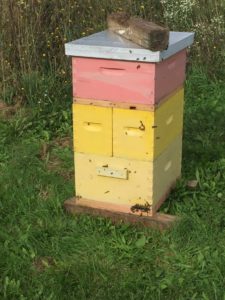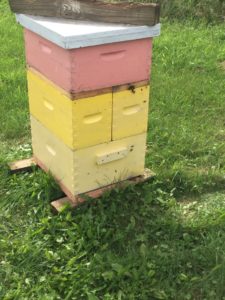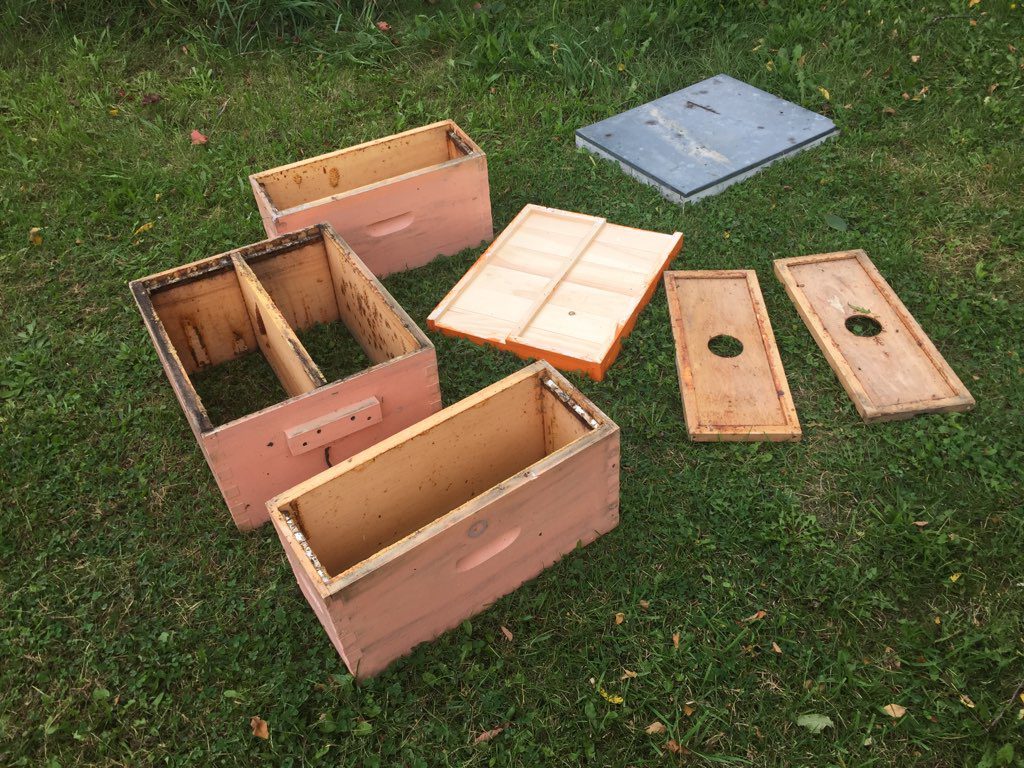Bee Lines: Double nuc box
by Sam Hall –

 It seems here in western New York that from about July 1st onward we are getting ready for winter in the beeyard. I have somehow ended the summer with seven nucs. I know what I’m going to do with five of them but not the last two. Four of them I will use in double nuc boxes. These a
It seems here in western New York that from about July 1st onward we are getting ready for winter in the beeyard. I have somehow ended the summer with seven nucs. I know what I’m going to do with five of them but not the last two. Four of them I will use in double nuc boxes. These a
re two side-by-side nuc boxes with a single bottom board with entrances at each end so the colonies do not mix. They are side by side so they can have the advantage of the creation of more heat than either could generate alone.
My experience has been that the colony with the entrance facing south always survives but the colony with the northerly entrance usually does not make it. So this year I have put them in a more sheltered place and orientated the entrances in a northeast southeast direction. I have placed two strong colonies in the double nuc box and the pictures are of the two entrances to the box with the bees using both the upper and bottom entrances. The pink 10 frame super on top is to protect the two Boardman feeding jars. The syrup is 2 parts sugar and 1 part water. Both colonies are taking a quart of syrup a day. I will continue feeding this right up to when the weather will prevent it which usually is early January. There is also a picture of another double nuc box showing the individual parts.

One of the nucs I’m going to use as a “nuc bomb” in a weak colony. This colony has been having queen problems much of the year. I will be placing this 5 frame nuc with a very vibrant local queen, which I raised, in the bottom super with a single sheet of newspaper over the top and make a couple of passes over the newspaper with a box cutter to get the bees into eating out the barrier between them. The newspaper slows them down so they will get used to each other. I will try and find the resident queen if there is one and remove her before I “bomb” it. This colony I will also start feeding also a 2 to 1 syrup using a large top feeder as I want them to take as much as possible down to store if need be. I will also feed them as long as the weather will allow and then recommence feeding in late February or early March.
Last Saturday I was picking up some old nuc boxes next to my shed and did not realize that hornets had built their paper nest in one until I was stung several times. Luckily I am not allergic and was eventually able to get away from them and then when properly dressed went back and removed them. Since then I have become aware of another nest in another stored nuc box, which I will eliminate. This type of wasp is after honey and can devastate a weak colony unless dealt with.
I will monitor the bee yard more closely for their presence. If I still see them after the nests are gone I will hang a few traps in the yard. I haven’t had to use traps in years. They are simple to make. Take an empty plastic half gallon milk bottle, cut a small slit in the bottle lower than the flange from the neck. The slit should be about ½ inch wide and about an inch to inch and a half long and parallel with the bottom. Take a cup of hot water and mix a little strawberry jam into it and then put it in the trap and hang it in your bee yard. When I first did this I was nervous about getting honey bees into the trap but they don’t bother it.
I had to remind myself while I was suffering somewhat from the hornet attack of what the German Philosopher Friedrich Nietzsche said “That which does not kill us, makes us stronger.” I’m waiting for my additional strength.
Editor’s Note – I’d be wealthy if I collected a dollar for every time someone said “bee” when what they were really talking about was a wasp, hornet or other stinging insect. One thing I have learned in working with honey bees is that they are rather nice creatures. Sure, if provoked, they will sting to protect their homes, but they are not agressive the way some other such creatures (like hornets) are. I often say to people” Are you sure it was a bee?” The answer is often no. It is well worth the time it takes to find out what an insect is before labeling it a “bee.” Calling everything that stings a bee gives nice bees a bad rap..
_________________
Sam Hall is a Western NY beekeeper who first worked bees as a child growing up on a ‘dirt farm’ in Allegany County, NY. He has kept bees for most of his adult life and believes that his mistakes ‘far outnumber his successes.’